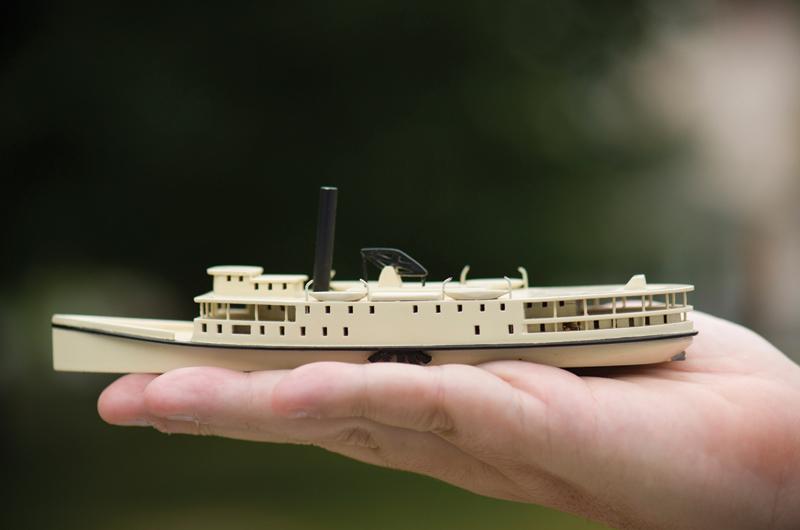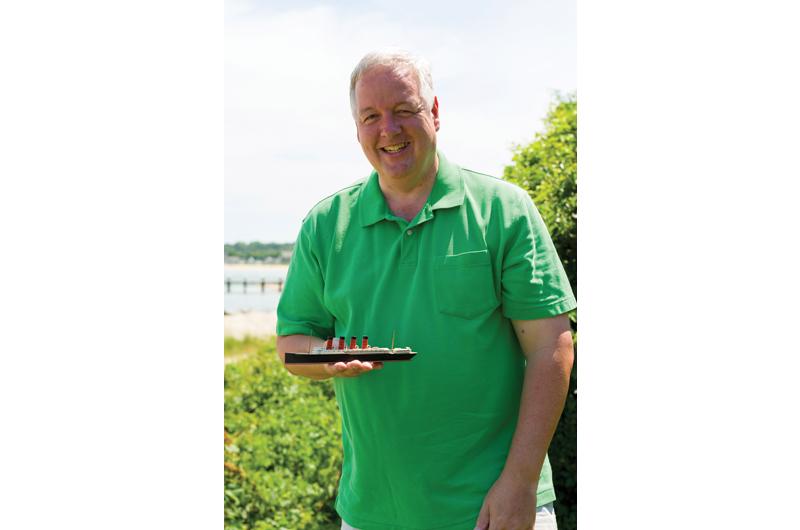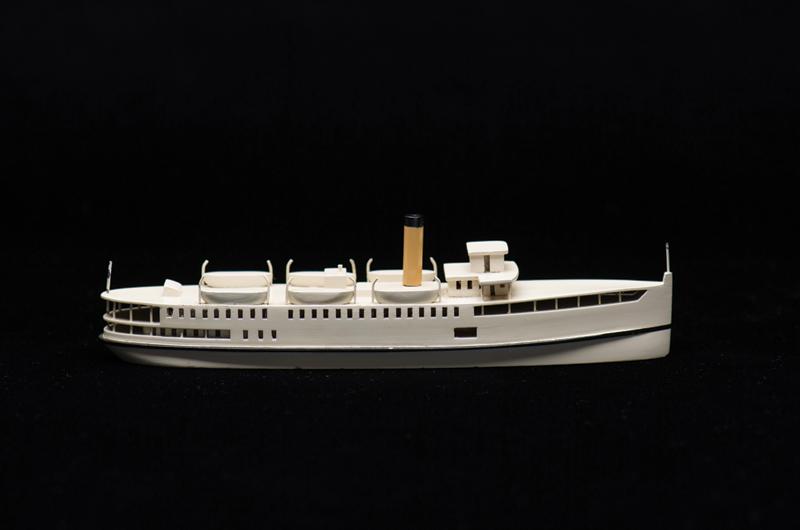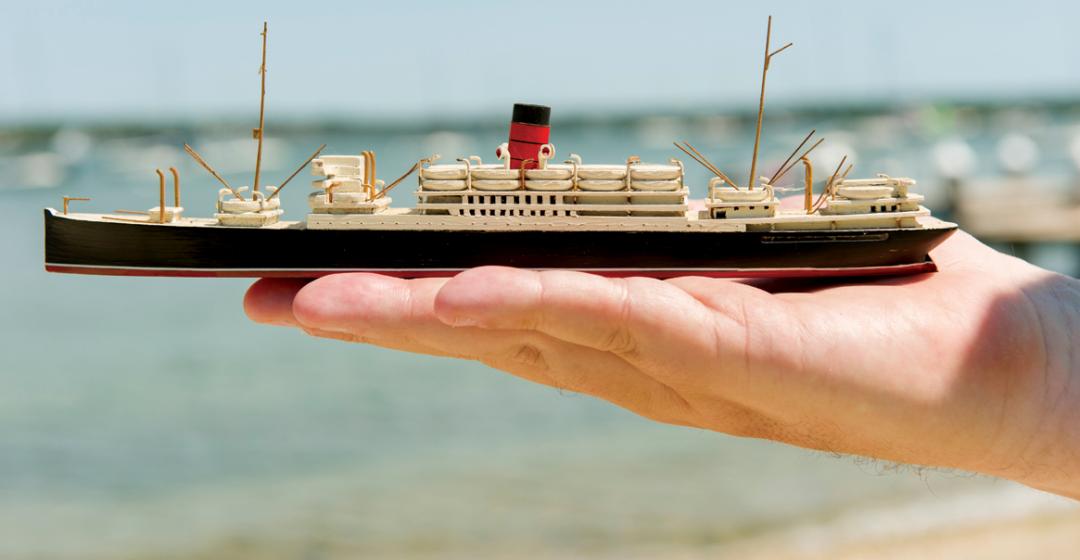Before Gannon and Benjamin made the shores of Beach Road a mecca for wooden-boat lovers, before Erford Burt set up shop in a relocated church on the western arm of the Lagoon, there was another boatyard in the shadow of Five Corners in Vineyard Haven. The vessels built there were miniatures – meticulously crafted scale models made of poplar and brass and automotive lacquer – and they “sailed” to their final destinations in cardboard boxes and wooden shipping crates. They made port at shipyards, in shipping-line offices, and on the curio shelves of travelers eager for mementos of their ocean voyages. They found their way into the homes of two presidents, and played a small role in the greatest war in history. “Van Ryper of Vineyard Haven” – to two generations of residents and visitors, simply “the ship model shop” – is only a memory now, but in its thirty years (ending in 1962) it built a tabletop fleet 15,000 vessels strong.
The story began in the waning years of the Hoover administration with a small boy and an even smaller boat. My grandfather, Charles King Van Riper (Charlie or C.K. to his friends), had brought his wife and son east from California for the summer to visit family: his mother-in-law (whose nickname, Mimi, belied her formidable size and Queen Victoria wardrobe) on the coast of Maine, and his brother Donald, who’d recently settled on the Vineyard. Fondly told that he would soon have a chance to ride on a ferry, my father – according to family legend – asked: “What’s a ferry?” Inspired, Van Riper disappeared into Mimi’s barn and emerged some time later with a toy replica of the then-new Island steamer Naushon, cobbled together from wood scraps and whitewash.
Van Riper was no master woodworker, but he had an endlessly creative mind and a boundless enthusiasm for new challenges. Watching the toy Naushon he’d built make voyage after voyage across his mother-in-law’s rug, a new idea took hold. Ship models – replicas of particular ships, built to a precise scale – had traditionally been handcrafted works of art built one at a time by individual craftsmen. Representing an investment of hundreds, even thousands, of hours on the part of the builder, they commanded prices to match. What if, Van Riper asked himself, you could build scale-model ships the way Henry Ford built cars: turning them out in large enough quantities that they could be sold relatively inexpensively? Then you could market them to middle-class travelers as keepsakes and mementos. Sail to the Vineyard or Nantucket for the summer, and bring home a model of the steamer that brought you there. Cross the Atlantic on the Mauretania or the Pacific on the Empress of India, and order a replica for your mantelpiece.

The shop opened for business (using the Old World spelling, “Van Ryper,” to make its pronunciation clear) in 1933. A two-story wooden building on Beach Road, beside Harry Peakes’s ice house, served as a combination workshop, office, and showroom. Under its roof Van Riper gathered a small group of talented, eccentric individuals: craftsmen hired to provide the skills he himself lacked. Frank Canha, Arthur King, and Arthur Andrews did the woodwork in the shop’s early years; John Canha drafted the plans; and Benjamin Baptiste wielded the paint sprayer. Mel Doremus handled the fine-detail and finish work, while Ray Chipman acted as shop foreman and bookkeeper. Van Riper himself was the creative spark: publicist, salesman, strategist, and innovator in chief. He filled orders, greeted customers in the showroom, and spun out an endless series of ideas for new products. He was, to use a word not yet common in the 1930s, an entrepreneur.
His first, greatest innovation – the one that made the shop viable and set the stage for the others that followed – was simply this: never, ever make just one of anything. The time required for a worker to turn a block of poplar into a precisely shaped hull or deckhouse was, Van Riper realized, mostly spent setting up and adjusting the tools. The actual cutting and sanding was quick by comparison, and making two hulls took only a few more minutes than making one. The vast majority of Van Ryper models were, therefore, made in batches. A woodworker would cut twenty-four Mauretania hulls in rapid succession, reset the guides on his table saw and produce twenty-four deckhouses, then set them a third time and turn out ninety-six funnels (since each model would require four). Once cut, drilled, and sanded, the wooden components would be handed off to a painter who, after loading his spray gun with black automotive lacquer, would paint all twenty-four hulls, before switching to white for the decks and deckhouses, or Cunard Lines’ trademark red for the funnels. The shop’s final-assembly workers and decorators used a similar approach, setting up for a particular operation and then carrying it out on all the models in a given batch, one after another. The process was mass-production in miniature, and it resulted in a high-quality product that could be sold at prices ordinary Americans could afford.
Van Riper’s second critical insight was that shop models didn’t have to recreate every detail of the ships they represented – just enough detail to make them look right. “Enough,” he decreed, was whatever could be seen from a distance of two to five miles, as if the observer were viewing it from shore or the deck of another ship. Drawing on Van Riper’s suggestions and their own ingenuity, the shop’s workers became masters of eye-fooling techniques that suggested, rather than precisely replicated, critical details. Strips of beaded wooden furniture trim were fashioned into lines of lifeboats, finish nails and bent common pins into davits, and glazier’s points into the part of the rudder that peeked above the water. Tiny drill holes in the sides of the hull represented portholes, and shallow cross-cuts with a narrow-bladed saw made the “windows” in the deckhouses. Anchors, invisible to Van Riper’s imaginary observer and all but impossible to counterfeit effectively at small scales, were simply left off.
The two innovations came together in the Travel Series, a collection of relatively simple models representing the vessels of major passenger lines. Advertised as “Models of Ships on which You’ve Sailed,” they were the fulfillment of Van Riper’s original vision for the business: attractively priced keepsakes for travelers who wanted to remember their ocean voyages. The Travel Series models were built to a standard length of nine to eleven inches long, ensuring that a group of them (the advertising slogan, with its subtle use of the plural “ships” assumed repeat business) would make a harmonious display on a customer’s shelf. On most, therefore, an inch on the model was the equivalent of roughly forty-five feet on the real-world ship it represented. However, keeping models of late-1930s “super liners” like France’s Normandie and Britain’s Queen Mary to a length of eleven inches – standard for the Travel Series – meant using a smaller scale, with an inch representing roughly sixty-four feet of the actual ship.
Attractively priced – the ferry Martha’s Vineyard sold for $3.50 in 1937, and the Cunard liner Mauretania for $5.75 – the Travel Series sold quickly and widely. A brochure from that year listed more than 250 different ships in stock and ready to mail out. Larger, more detailed models of selected ships were also available at higher prices (a sixteen-inch replica of the thousand-foot Normandie cost $15 in 1940, compared to less than $10 for the Travel Series), and yacht owners willing to supply the necessary plans and photographs could order a custom replica of their vessel in any size their budget would allow. This ability to mass-produce a wide range of standardized models while simultaneously handling more complex projects became, a few years later, the basis of the Van Ryper shop’s contribution to the war effort.

The shop's transition to a wartime footing began in 1938, long before the first bombs fell on Pearl Harbor. The Moore-McCormack shipping line, having accepted a contract to operate ten government-owned merchant vessels, wrote to Van Riper to order a replica of one of them. The scale specified by Moore-McCormack (one inch = eight feet) meant that the finished model would be well over five feet long, and capable of depicting the ship at a level of detail unimaginable on a ten-inch Mauretania or fourteen-inch Normandie. The trompe l’oeil techniques used in the Travel Series models would not work at such sizes. Instead, the Van Ryper craftsmen scaled up the techniques they had begun to develop for building custom yacht models: working directly from shipyard plans and photographs supplied by Moore-McCormack, and precisely reproducing, rather than merely simulating, details like lifeboats, railings, booms, and winches.
The Moore-McCormack job led to a steady stream of additional requests for similarly sized models: from the Maritime Commission, charged with overseeing the expansion and modernization of the U.S. Merchant Marine, from other government agencies, and from the shipping lines themselves. Van Riper, always with an eye to publicity, offered to build a “liner of the future” for display at the 1939–40 World’s Fair in New York, but the organizers demurred. “Eighth scale” (as the shop crew called it, because 1/8–inch on the model represented one foot of the actual ship) quickly became the shop’s standard for corporate work, and over the course of the wartime and immediate postwar years, the shop’s magnificently elaborate eighth-scale models found their way into government agencies, corporate boardrooms, and the reception areas of shipyard and shipping-line offices. President Franklin D. Roosevelt, a former assistant secretary of the Navy and lifelong aficionado of all things maritime, kept an eighth-scale Van Ryper model of an EC-2 freighter (the prototype, ironically, for Henry Kaiser’s mass-produced Liberty Ships) on display in the study of his Hyde Park, New York, mansion.
Even the big eighth-scale models were dwarfed, however, by a model of a T-2 tanker ordered in 1942 by a Kaiser shipyard in Portland, Oregon. The T-2s were petroleum-carrying counterparts of the Liberty Ships, and like their more famous cousins they were mass-produced: built in sections that were welded together during the final assembly process to make a complete ship. The Portland yard wanted its model made, like the real thing, in five separate sections: a three-dimensional reference to show the foremen of their construction crews exactly how the finished product went together. Virtually every part of the full-sized hull, except the outer hull plating and some of the braces and bulkheads, was to be replicated in the model in its proper shape and position. The miles of pipes and cables that knitted the ship together would all be there in miniature, routed through the model just as they were through the actual ship. The completed model would be twenty-seven feet long, each of its five sections as long as an eighth-scale model of a freighter.
Four sections of the metal model had been completed, crated, and dispatched to Portland, Oregon, by rail when, on a July night in 1942, disaster struck. The workshop caught fire, gutting the interior and melting the almost-complete fifth section into unusable slag. Surveying the ruins the next morning, Van Riper purchased the Chimney House across the street and moved production of the T-2 model into it. Working from a new set of plans flown in from Oregon, Stan Lair and his crew of metalworkers worked overtime cutting, soldering, and welding together a new fifth section. The contract was met, and the final section dispatched to Portland, without even a single day’s delay.
Across the street, the woodworking crews rebuilt their workspace and restarted production of Van Ryper’s other major contribution to the war effort: recognition models. These also were training aids, used to teach sailors and naval aviators how to recognize enemy warships by their distinctive silhouettes. Studying the models from multiple angles would, the Navy believed, help to ensure that new recruits would not misidentify enemy destroyers as enemy battleships or mistake Allied vessels for Axis ones. An order for 2,300 models representing the entire Imperial Japanese Navy was placed and filled before the United States officially entered the war. Similar contracts for the German and Italian navies soon followed, as did contracts for recognition models of German and Japanese warplanes. Built mostly at a scale of one inch = sixty-four feet, the recognition models were similar in spirit to the Travel Series: representations of what the full-size ship would look like if seen at sea from a distance of several miles. Ranging from eight to twelve inches long and painted a uniform medium gray, they captured the shapes and positions of turrets, smokestacks, and deckhouses with perfect fidelity, but omitted small details like lifeboats and anti-aircraft guns. The aircraft models were similarly designed: built with landing gear retracted, bomb bay doors closed, and details that would interrupt their basic silhouette omitted. Test photos taken outside the shop show them dangling from barely visible fishing line with celluloid disks representing their spinning propellers, “flying” through the bright blue skies of summer.

At its wartime peak, the Van Ryper shop ran double shifts to keep up with the demand created by government contracts. In peacetime, it shrank back to its prewar size, and shifted back to liners, freighters, and yachts. New “Models of Ships on which You’ve Sailed” – similar in size to the prewar Travel Series, but more finely made and richly detailed – filled the showroom, now located in a small building of its own just in front and to the right of the main workshop. There they mingled with a handful of large eighth-scale ships that displayed the shop working at the peak of its abilities, along with model-embellished lamps, desk boxes, and wall plaques. The most famous of the latter displayed a half-model of the lightship Relief, her name written in large white letters on her fire-engine-red hull. Designed to mark the door to “that certain room” in one’s house, the plaque was the shop’s all-time best-seller. The showroom was a favorite destination for ship lovers and, especially on rainy days, families with small children. Charlie Van Riper – as always, the public face of the business – welcomed them all.
Sales were another matter. Rising postwar wages, and rising prices for materials, meant that a model that sold for $5 or $6 in the mid-1930s now retailed for $10, $12, or $15, edging out of the reach of less-prosperous customers. Postwar liners, like William Francis Gibbs’s magnificent United States, featured elaborately curved hulls and complex superstructures that required more time and expense to replicate than those of prewar ships. Eighth-scale models remained popular with shipping companies and big-city travel agencies – the Isbrandtsen Line ordered a replica of each vessel in its fleet in the early 1950s – but the market was limited. Few individuals could afford to pay for a five- to six-foot ship model, let alone a house with room to display it.
Van Riper’s biggest postwar challenge, however, was that the pool of Americans who traveled by ship was shrinking. The Fall River Line, once the preferred carrier of New Yorkers headed to the Vineyard, went out of business in 1937, a victim of improved road and rail service in southern New England. A decade later, Northeast Airlines began service from Boston to the newly opened Martha’s Vineyard Airport, making the trip in less time than it took a ferry to cross from Woods Hole to Vineyard Haven. Airliners also brought Hawaii, South America, and Europe within the reach of America’s coastal cities, rolling out no-frills, tourist-class service in the early 1950s that captured precisely those travelers who had once gone by sea and then turned to the Van Ryper shop for mementos of their sea voyages.

Van Riper, ever inventive, compensated by expanding into new areas. There were maritime-themed lamps and wastebaskets, wooden fishes (as carefully shaped and painted as duck decoys) to be hung on the wall as works of art, assemble-it-yourself wooden model kits, and a table-top game of his own invention in which players raced liners across the ocean. The shop accepted orders from customers with models that needed cleaning or repair, and built a replica of Noah’s Ark based on a design that one customer had extrapolated from Genesis. Models of sailing vessels – whether modern racing sailboats like the Vineyard Haven 15 or the whalers and cargo schooners of days gone by – became a larger proportion of the output. Among the latter was a model of the Continental Navy’s sloop-of-war Wasp, ordered in 1960 with the condition that the unnamed buyer be allowed to inspect it at his home before closing the deal. Van Riper agreed and, with the Wasp safely nestled in a custom-made wooden case, set out for the mainland; the destination was an address in Hyannisport, and the buyer was Senator – soon to be President – John F. Kennedy. The model found favor with JFK, and (despite a lifetime of voting Republican) Van Riper emerged from the meeting a committed Democrat.
The crew, by then, was the same size it had been in the early days, but the old-timers had long since moved on, and their replacements were now old-timers in their own right. Eldon West acted as foreman and built yacht models in a corner of his office; Freeman Leonard focused on corporate work, including exotic projects like river dredges and offshore oil rigs as well as ships; Cliff Dugan handled the woodwork; Stan Lair the metalwork; and Phil Horton oversaw the decorating and detailing. The business itself had entered old age as well, however, and Van Riper recognized that the end was coming. Jet airliners, capable of crossing the Atlantic nonstop in six hours, had put most of the traditional passenger liners out of business in the late 1950s. In 1960, after suffering a stroke, Van Riper closed down production at the shop. He kept the showroom open for two more years, selling off the remaining stock and keeping his hand in the part of the business that had always brought him the greatest satisfaction.
Charlie Van Riper died in 1964, and my father (for whom that first Naushon was made) in 2001, but “Van Ryper of Vineyard Haven” never entirely faded away. Models that originally sold for $5 or $6 now regularly change hands for $200 to $500, and though the shop has been closed for fifty-five years, I still get phone calls that begin: “Are you related to the Van Ryper who built the ship models...?” “Yes”, I answer, knowing that the response will likely bring forth a fond memory of long-ago visits to the shop, or news of a model still proudly displayed far from Vineyard Haven harbor. The world that gave birth to them is long gone now, but the miniature fleet launched on the shores of Beach Road still sails the seas of the imagination, their bright-colored funnels gleaming in the sun.




 6 comments
6 comments
Comments (6)